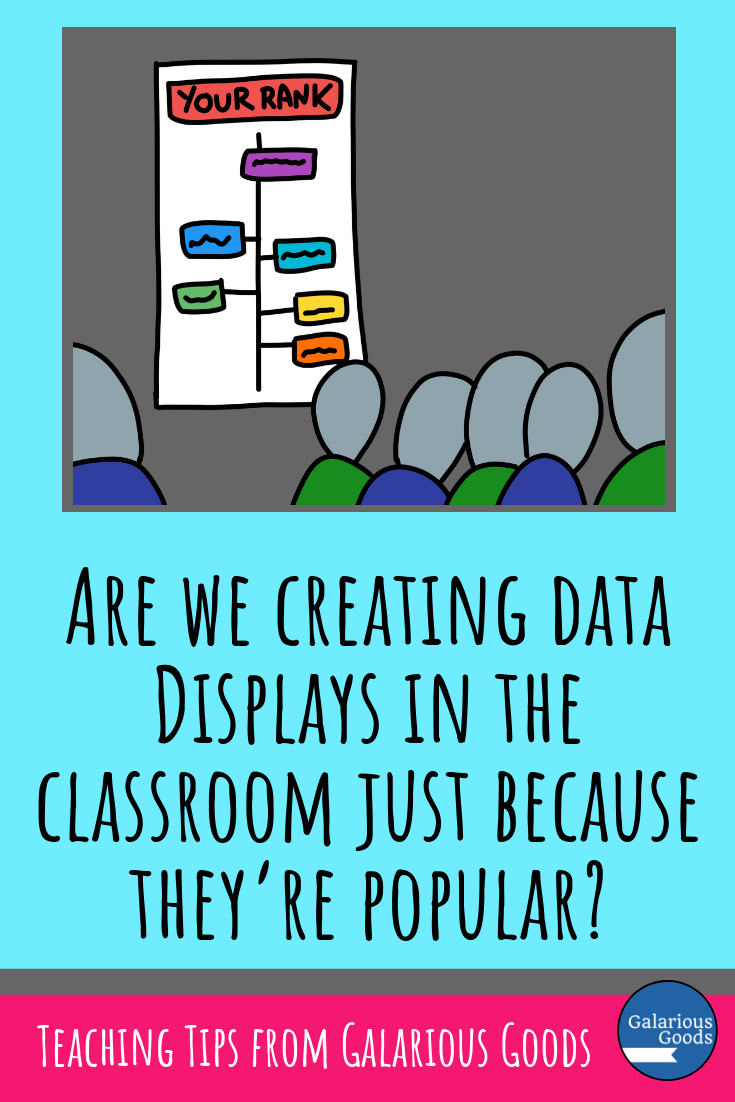Don't Put My Child On Your Classroom Data Wall
/In the lead up to the 2019 school year, Instagram was filled with teachers creating beautiful things for beautiful classrooms. But as the parent of a school-aged child, one thing worried me - the number of displays which were created just to share the academic and behavioural levels of children in the class.
And - as a parent - I’m asking you to take children off your classroom data walls.
Whether it’s reading levels, test scores, behaviour, number of books read or goals achieved, our schools are filled with data. But should those data levels be publicly displayed on the wall of our classrooms?
The call for ‘accountability’ - mostly stemming from No Child Left Behind (an early 2000’s government initiative from the United States), led to the call for more and more data to be collected, recorded, analysed and displayed. One way this was achieved was by creating data walls for teachers to use. These were placed in teacher areas - like staff rooms or planning rooms - where they could be used for planning and evaluation. But slowly, these walls of academic and behavioural levelling crept out of the teacher areas and onto the walls of the classrooms. It is these classroom displays which concern me as a parent and a teacher - for a number of reasons.
1. The Privacy of Our Students
Once a child’s name is attached to a levelled display in the classroom, they lose the privacy of their own achievement level. Every classmate, every other student who comes into the room, every parent can see exactly what behaviour level students are at or what reading level they have achieved and how they compare with other students.
In some places around the world, these data walls actually break laws protecting student privacy. But even when they don’t, these walls - which are often put up without the permission or knowledge of parents - share information about students which should be kept for the students, their parents and the staff of the school. I had to give parental permission for my son’s kindergarten to share his learning statement with his school - but few teachers ask for permission to share reading levels, behaviour levels or achievement levels with anyone who looks into the classroom.
2. The Lack of Context
A display showing how many books a child has read over the year sounds like a great thing. But when Alice is reading picture books and Bill is reading novels, Alice is obviously going to look better on the chart.
Lack of context is a serious problem for a wall chart - yet that is what students see, day after day. For some students learning comes super easy. They absorb the information, share the information and it all takes very little effort. For others, they can work extremely hard at school and at home and - on paper at least - show very little progress.
Even if Bill knows he’s only read half as many books as Alice because he’s reading much longer than books than she is - he knows that his number of books looks ‘small’. It takes away some of the pride that he might feel for being able to read longer books, or - at worst - tells him that he should also swap to picture books so he can have a lot of books to add to the chart on the wall.
You cannot easily add context to a chart on the wall in your classroom - not in a way which will help your students to understand it.
3. Is There Evidence That They Work?
The short answer to this is no. When researchers from Australian Catholic University examined the research, they found only one example of research showing positive results for TEACHERS using data walls - and nothing about classroom displays making a difference to students.
Australian authorities and school administrations often point to one school in Australia which showed improvement after putting data walls up where everyone could see them. However, this is a) isolated, b) focused on a particular population of students and c) was combined with a significant program of improvement - much more than just a data wall.
So, why are we doing it? Are we creating walls just because they’re popular? Or because admin told us to?
4. Does Your Data Display Harm Your Students?
Have you got anxious students in your class? Imagine being the anxious student working hard to go up the behaviour wall, but for some reason you don’t seem to be moving, no matter how hard you try. While your behaviour continues to be good at school - because you’re striving to be moved on that wall you see every session of every school day - your behaviour at home is deteriorating because you’re frustrated and you just don’t know what’s wrong with you.
Or what if that data wall becomes your sole focus in class. You’re no longer interested in classes which don’t progress you on the wall, or learning for the joy of learning. You just want to see that peg with your name on it moved.
Or what if you just cannot get past other people on that chart - if no matter what you do, you’re always on the bottom.
As a teacher, you may not see the harm these charts are doing to your students - students can be remarkably good at masking how they feel to fit in. But parents see it at home. We see it in poor behaviour and loss of enthusiasm for school. We see it in school refusal and constant anxiety related illness.
5. Do your data displays allow for outlying students?
Have you got a goals chart in your room? A chart with the standards for your grade level, and places to put the students as they’re striving to meet those standards?
What are you going to do when a student walks into your class and they’ve already met those standards? Your display has told that student and their parents that you have no goals for them to meet - that there is no learning place for them in your classroom.
If you’re measuring reading levels, where do students go when they’ve already reached the top level?
What about a student who is working on goals or levels which are not easily seen on a standard chart?
What’s the alternative?
The good news is that if you’re all about data, there are alternatives to classroom data walls. Data walls in teacher spaces - either physical or digital - can be a great tool when planning. There is no reason students can’t track their own data either - keeping it in a private place in their own notebooks and creating their own learning or behaviour goals.
Classes can also create collaborative displays. Recording the amount of books read by a class can be incredibly motivating (we kept ours on the door of our classroom and it provoked many conversations with students from other classes about why we enjoyed reading so much) - and every students contributes together from this. Similar things can happen with achievement levels - additions can be added to displays whenever any child in the class achieves a new level or has a particularly successful (for them) piece of work.
We can also acknowledge a full range of classroom achievements - from being a good sport during a sports lesson to using particularly good words in a piece of writing. We can make our classrooms places of joyful learning, instead of places where everyone is just trying to climb the ladder to their next regimented success.

















